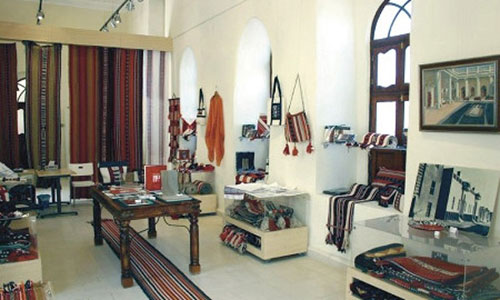
Al Sadu weaving is an embroidery form in geometrical shapes hand woven by Bedouin people. This traditional art form was developed by the nomadic Bedouins over centuries and was facing extinction because of modernization. To protect this traditional art form of hand weaving with dyed, spun and colored wool, the Al-Sadu Society was formed in 1979. In addition to reviving the ethnic art of hand weaving, they also contributed a lot to protect the Bedouin community. As a result of the society's efforts, the Al Sadu House came up in 1980. Towards 1984 end, the Al Sadu House had registered 300 Bedouin women and they are producing about seventy different items every week.
The Al Sadu House which protects the interests of the Bedouins and their ethnic handicrafts is a unique tourist attraction of Kuwait and is located close to the National Museum of Kuwait.
My visit to Al Sadu House, the home of traditional weaving of the desert, has reinforced my feeling that the world is a small place. “Al Sadu” is a term used by the Bedouins to mean their weaving process, the woven objects and the ground loom. Bedouins are the nomadic inhabitants of the desert generally referring to the nomads of Arabia (Saudi Arabia), Negev (Israel) and Sinai (Egypt). They are recognized by their nomadic lifestyle, specific dialect, social structure, culture and their weaving. The nomadic Bedouins live in tents that are woven by their women folk. These tents are special in the sense that it has to weather the harsh desert winds of summer and winter with extreme temperature conditions that raise dust storms from time to time. Hence they use a variety of materials for weaving which include sheep’s wool, goat and camel hair, cotton and manmade fibers. These animals are part of their existence in the harsh desert environment. Wool weaving is one of the oldest crafts practiced by the Bedouins. They mainly use wool from their herds to produce many utilitarian items that suit the Bedu migratory lifestyle. Most important items are their black tent or “Bayt al Shaar”, dividers inside the tent, storage bags, clothes, camel seats, rugs, cushions, decorative piece, animal trappings etc. The goat yarn which is the most difficult to spin is used for weaving tents, because of its oily texture. Their crafts require a high degree of dexterity and skill. Their weaving skill is appreciated within the community and competitions among women are organized to find the best weaver who is given the title “Urfa” meaning victorious.
In Al Sadu House, experts work with weavers to better and preserve the craft. The house is beautifully decorated with handicrafts, potteries and weaving looms. The crafts of knitting wool, weaving and tent making by the Bedouins are displayed in this museum.There’s also provision to show a short movie to visitors about Bedouin’s craft. One can also purchase Bedouin textiles or wall hangings from Al Sadu House.
But what struck me when I saw the craft is its similarity with Naga handicrafts of India. Both the communities use similar patterns and geometrical designs. The Bedouins also uses patterns like camel insignia, desert utensils etc, that reflect the life of the desert. Wool is also extensively used in their weaving to protect them from the biting desert cold of the winter season. Again like the Nagas they also use the combination of red, black, white wool and cotton threads. Isn’t it strange that one community living in the Arabian Deserts and another in remote North Eastern hills of India have similar weaving techniques and patterns? The globalized nature of their work is also reflected by the resemblance of their work with Rajasthani handicrafts. The Bedouin makes extensive use of beads in their weavings which is similar to the handicrafts from Rajasthan. The ‘bisht (men’s cloak) embroidery’ of the Bedouins is similar to the ‘zardoji crafts’ of Uttar Pradesh. Just like the ‘karigars’ of zardoji weave gold, silver or base metal threads as silk threads, the ‘al mejaben’ hand embroideries threads of gold, silver or threads coated with gold in bisht’s neckline, front opening, sleeve seams and cuffs. The colored silk thread called ‘brisim’ is also used in the design or as a contrast to the zari. Once completed, the embroidery is hammered with a large iron punch to smooth any rough edges in the metal thread. If properly cared for, its glitter and shimmer will last for a long time.
Thus I felt a sense of identity with the Bedouin crafts as I moved around the Al Sadu House.
Entry to the Al Sadu House is free.
Opening hours: Saturday to Thursday
8am to 1pm and again from 4pm to 8pm
Contact Number: 22432395